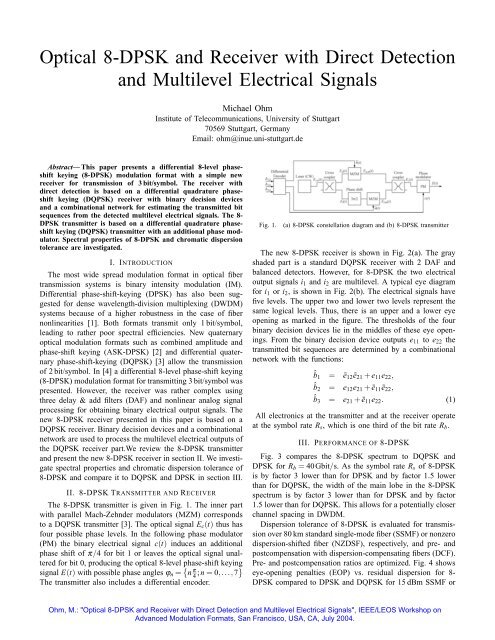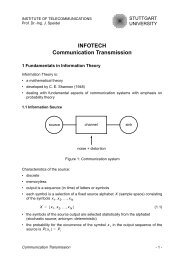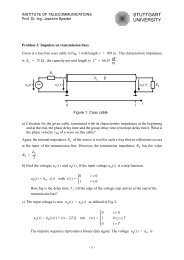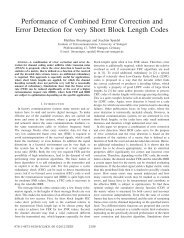Optical 8-DPSK and Receiver with Direct Detection and Multilevel ...
Optical 8-DPSK and Receiver with Direct Detection and Multilevel ...
Optical 8-DPSK and Receiver with Direct Detection and Multilevel ...
You also want an ePaper? Increase the reach of your titles
YUMPU automatically turns print PDFs into web optimized ePapers that Google loves.
<strong>Optical</strong> 8-<strong>DPSK</strong> <strong>and</strong> <strong>Receiver</strong> <strong>with</strong> <strong>Direct</strong> <strong>Detection</strong><strong>and</strong> <strong>Multilevel</strong> Electrical SignalsMichael OhmInstitute of Telecommunications, University of Stuttgart70569 Stuttgart, GermanyEmail: ohm@inue.uni-stuttgart.deAbstract— This paper presents a differential 8-level phaseshiftkeying (8-<strong>DPSK</strong>) modulation format <strong>with</strong> a simple newreceiver for transmission of 3 bit/symbol. The receiver <strong>with</strong>direct detection is based on a differential quadrature phaseshiftkeying (DQPSK) receiver <strong>with</strong> binary decision devices<strong>and</strong> a combinational network for estimating the transmitted bitsequences from the detected multilevel electrical signals. The 8-<strong>DPSK</strong> transmitter is based on a differential quadrature phaseshiftkeying (DQPSK) transmitter <strong>with</strong> an additional phase modulator.Spectral properties of 8-<strong>DPSK</strong> <strong>and</strong> chromatic dispersiontolerance are investigated.I. INTRODUCTIONThe most wide spread modulation format in optical fibertransmission systems is binary intensity modulation (IM).Differential phase-shift-keying (<strong>DPSK</strong>) has also been suggestedfor dense wavelength-division multiplexing (DWDM)systems because of a higher robustness in the case of fibernonlinearities [1]. Both formats transmit only 1 bit/symbol,leading to rather poor spectral efficiencies. New quaternaryoptical modulation formats such as combined amplitude <strong>and</strong>phase-shift keying (ASK-<strong>DPSK</strong>) [2] <strong>and</strong> differential quaternaryphase-shift-keying (DQPSK) [3] allow the transmissionof 2 bit/symbol. In [4] a differential 8-level phase-shift keying(8-<strong>DPSK</strong>) modulation format for transmitting 3 bit/symbol waspresented. However, the receiver was rather complex usingthree delay & add filters (DAF) <strong>and</strong> nonlinear analog signalprocessing for obtaining binary electrical output signals. Thenew 8-<strong>DPSK</strong> receiver presented in this paper is based on aDQPSK receiver. Binary decision devices <strong>and</strong> a combinationalnetwork are used to process the multilevel electrical outputs ofthe DQPSK receiver part.We review the 8-<strong>DPSK</strong> transmitter<strong>and</strong> present the new 8-<strong>DPSK</strong> receiver in section II. We investigatespectral properties <strong>and</strong> chromatic dispersion tolerance of8-<strong>DPSK</strong> <strong>and</strong> compare it to DQPSK <strong>and</strong> <strong>DPSK</strong> in section III.II. 8-<strong>DPSK</strong> TRANSMITTER AND RECEIVERThe 8-<strong>DPSK</strong> transmitter is given in Fig. 1. The inner part<strong>with</strong> parallel Mach-Zehnder modulators (MZM) correspondsto a DQPSK transmitter [3]. The optical signal E c (t) thus hasfour possible phase levels. In the following phase modulator(PM) the binary electrical signal c(t) induces an additionalphase shift of π/4 for bit 1 or leaves the optical signal unalteredfor bit 0, producing the optical 8-level phase-shift keyingsignal E(t) <strong>with</strong> possible phase angles ϕ n = { n4 π ;n = 0,...,7}The transmitter also includes a differential encoder.Fig. 1.(a) 8-<strong>DPSK</strong> constellation diagram <strong>and</strong> (b) 8-<strong>DPSK</strong> transmitterThe new 8-<strong>DPSK</strong> receiver is shown in Fig. 2(a). The grayshaded part is a st<strong>and</strong>ard DQPSK receiver <strong>with</strong> 2 DAF <strong>and</strong>balanced detectors. However, for 8-<strong>DPSK</strong> the two electricaloutput signals i 1 <strong>and</strong> i 2 are multilevel. A typical eye diagramfor i 1 or i 2 , is shown in Fig. 2(b). The electrical signals havefive levels. The upper two <strong>and</strong> lower two levels represent thesame logical levels. Thus, there is an upper <strong>and</strong> a lower eyeopening as marked in the figure. The thresholds of the fourbinary decision devices lie in the middles of these eye openings.From the binary decision device outputs e 11 to e 22 thetransmitted bit sequences are determined by a combinationalnetwork <strong>with</strong> the functions:ˆb 1 = ē 12 ē 21 + e 11 e 22 ,ˆb 2 = e 12 e 21 + ē 11 ē 22 ,ˆb 3 = e 21 + ē 11 e 22 . (1)All electronics at the transmitter <strong>and</strong> at the receiver operateat the symbol rate R s , which is one third of the bit rate R b .III. PERFORMANCE OF 8-<strong>DPSK</strong>Fig. 3 compares the 8-<strong>DPSK</strong> spectrum to DQPSK <strong>and</strong><strong>DPSK</strong> for R b = 40Gbit/s. As the symbol rate R s of 8-<strong>DPSK</strong>is by factor 3 lower than for <strong>DPSK</strong> <strong>and</strong> by factor 1.5 lowerthan for DQPSK, the width of the main lobe in the 8-<strong>DPSK</strong>spectrum is by factor 3 lower than for <strong>DPSK</strong> <strong>and</strong> by factor1.5 lower than for DQPSK. This allows for a potentially closerchannel spacing in DWDM.Dispersion tolerance of 8-<strong>DPSK</strong> is evaluated for transmissionover 80 km st<strong>and</strong>ard single-mode fiber (SSMF) or nonzerodispersion-shifted fiber (NZDSF), respectively, <strong>and</strong> pre- <strong>and</strong>postcompensation <strong>with</strong> dispersion-compensating fibers (DCF).Pre- <strong>and</strong> postcompensation ratios are optimized. Fig. 4 showseye-opening penalties (EOP) vs. residual dispersion for 8-<strong>DPSK</strong> compared to <strong>DPSK</strong> <strong>and</strong> DQPSK for 15 dBm SSMF or
43DBPSK − NRZ (SSMF)DBPSK − NRZ (NZDSF)DQPSK − NRZ (SSMF)DQPSK − NRZ (NZDSF)8−<strong>DPSK</strong> − NRZ (SSMF)8−<strong>DPSK</strong> − NRZ (NZDSF)EOP [dB]21(a)0Amplitude [µA]1000-1000 40 80Time [ps]120(b)−1−200 −150 −100 −50 0 50 100 150 200 250 300Residual dispersion r d[ps/nm]43(a)DBPSK − RZ 0.5 (SSMF)DBPSK − RZ 0.5 (NZDSF)DQPSK − RZ 0.5 (SSMF)DQPSK − RZ 0.5 (NZDSF)8−<strong>DPSK</strong> − RZ 0.5 (SSMF)8−<strong>DPSK</strong> − RZ 0.5 (NZDSF)Power [dBm]Fig. 2. (a) 8-<strong>DPSK</strong> receiver <strong>and</strong> (b) multilevel eye diagram for i 1 or i 2-10-20-30-40-50-80 -40 0 40 80Frequency relative to carrier [GHz]Fig. 3.(a)Power [dBm]-10-20-30-40-50-80 -40 0 40 80Frequency relative to carrier [GHz](b)Power [dBm]-10-20-30-40-50-80 -40 0 40 80Frequency relative to carrier [GHz]Spectra of (a) 8-<strong>DPSK</strong>, (b) DQPSK, <strong>and</strong> (c) <strong>DPSK</strong> (R b = 40Gbit/s)NZDSF input power. DCF input power is -2 dBm. Nonreturnto-zero(NRZ) <strong>and</strong> return-to-zero (RZ) impulse shaping <strong>with</strong>duty cycle 0.5 are considered. For NRZ, EOP of 8-<strong>DPSK</strong> isgreater than for <strong>DPSK</strong> <strong>and</strong> DQPSK <strong>with</strong> both fiber types. ForRZ, however, 8-<strong>DPSK</strong> has the lowest EOP for both SSMF<strong>and</strong> NZDSF. RZ-8-<strong>DPSK</strong> EOP curves are much wider thanRZ-DQPSK <strong>and</strong> RZ-<strong>DPSK</strong> EOP curves, stating a greaterdispersion tolerance. Further, NZDSF leads to a 1 dB lowerEOP than SSMF. Obviously, 8-<strong>DPSK</strong> is more susceptible toresidual dispersion <strong>and</strong> fiber nonlinearties than DQPSK <strong>and</strong><strong>DPSK</strong>. However, this can be overcome by RZ instead of NRZimpulse shaping. Negative EOP for RZ-8-<strong>DPSK</strong> in Fig. 4(b)result from impulse compression on the fiber as shown inFig. 5 for 15 dBm RZ-8-<strong>DPSK</strong> single span NZDSF transmission.The impulses of the received signal in Fig. 5(b) havereduced temporal width but increased amplitude compared tothe reference in Fig. 5(a), although the mean powers are equal.IV. CONCLUSIONWe presented a differential 8-level phase-shift keying modulationformat for transmitting 3 bit/symbol <strong>and</strong> a simplifiedreceiver similar to the DQPSK receiver. The lower symbolrate at a given bit rate leads to a narrower spectrum for 8-<strong>DPSK</strong> than for DQPSK <strong>and</strong> <strong>DPSK</strong> <strong>and</strong> also to transmitter <strong>and</strong>receiver electronics <strong>with</strong> reduced b<strong>and</strong>width requirements. Wefurther studied single channel transmission over one span ofSSMF or NZDSF, respectively. Although 8-<strong>DPSK</strong> <strong>with</strong> NRZimpulse shaping is very susceptible to intersymbol interferencecaused by dispersion <strong>and</strong> fiber nonlinearities, 8-<strong>DPSK</strong> <strong>with</strong> RZ(c)EOP [dB]210−1−200 −150 −100 −50 0 50 100 150 200 250 300Residual dispersion r d[ps/nm](b)Fig. 4. EOP vs. residual dispersion for one pre- <strong>and</strong> post compensated fiberspan <strong>with</strong> 15 dBm fiber input power <strong>and</strong> (a) NRZ <strong>and</strong> (b) RZ impulse shaping.Normalized Amplitude10-10 40 80 120Time [ps](a)Normalized Amplitude10-10 40 80 120Time [ps]Fig. 5. RZ-8-<strong>DPSK</strong> eye diagrams: (a) reference <strong>and</strong> (b) after single spantransmission <strong>with</strong> 15 dBm NZDSF input powerimpulse shaping exhibits a greater dispersion <strong>and</strong> nonlinearitytolerance than DQPSK <strong>and</strong> <strong>DPSK</strong>.ACKNOWLEDGMENTThis work was partially funded by the German Ministry ofEducation <strong>and</strong> Research (contract no. 01BP252).REFERENCES[1] M. Rohde, C. Caspar, N. Heimes, M. Konitzer, E.-J. Bachus, <strong>and</strong>N. Hanik, “Robustness of <strong>DPSK</strong> direct detection transmission formatin st<strong>and</strong>ard fibre WDM systems,” Electron. Lett., vol. 36, no. 17, pp.1483–1484, Aug. 2000.[2] M. Ohm <strong>and</strong> J. Speidel, “Quaternary optical ASK-<strong>DPSK</strong> <strong>and</strong> receivers<strong>with</strong> direct detection (ASK-<strong>DPSK</strong>/DD),” IEEE Photon. Technol. Lett.,vol. 15, no. 1, pp. 159–161, Jan. 2003.[3] R. A. Griffin <strong>and</strong> A. C. Carter, “<strong>Optical</strong> differential quadrature phaseshiftkey (oDQPSK) for high capacity optical transmission,” presented atOFC’02, paper WX6.[4] M. Ohm <strong>and</strong> J. Speidel, “Differential optical 8-PSK <strong>with</strong> direct detection(8-<strong>DPSK</strong>/DD),” in Voträge der 4. ITG-Fachtagung Photonische Netze,Leipzig, Germany, May 2003, pp. 177–181.(b)








